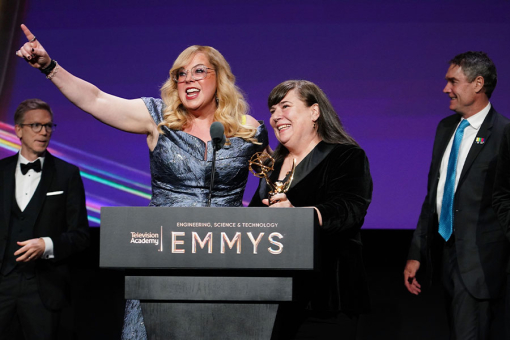In the Peacock limited series Angelyne, a reporter asks, "So, Angelyne, what, exactly, are you famous for?" As portrayed by Emmy Rossum (Shameless), the buxom blonde leans toward the microphone and responds, her cotton-candy voice dripping with scorn at the question: "I'm famous for being on billboards."
Before the Kardashians made famous-for-being-famous a thing in Hollywood, there was Angelyne, a young woman of mysterious origins who in the 1980s began popping up on billboards around Los Angeles, scantily clad and suggestively posed, her one-word moniker scrawled across the immense ads. She could — and still can — be seen tooling around town in a hot pink Corvette with personalized plates. That shrewd mix of L.A.'s pop and car cultures yielded small film and TV roles but mainly served to elevate her to icon status in the land of dreamers and wannabes.
In its five episodes, Angelyne tells a version of how Ronia Tamar Goldberg — born in Poland in 1950 to two Holocaust survivors who brought their family to L.A. — reinvented herself to become the person she felt she was meant to be: a sometime singer, actress, painter and even California gubernatorial candidate (twice). Most of all, as Rossum says in the show, she saw herself as "a bright pink light, here to inspire joy." Angelyne serves as an executive producer on the project, which was based on Gary Baum's 2017 article in The Hollywood Reporter magazine.
"Pink" was the operative word for production designer Jamie Hall and her team, who used the color only subtly in the early part of the story, usually in happier moments involving Angelyne's mother, who died of cancer when the girl was fourteen. "As [Ronia, who went by Renee in school] evolved into Angelyne, that's when you start seeing the pink," says Hall, who took over from original production designer Jahmin Assa when production resumed after an early pandemic shutdown.
"The pinks change throughout the course of the show, mostly in intensity, but also in undertone," explains Hall, whose previous credits include art direction on I Feel Bad and Get Shorty. "Things get stronger and bluer as time passes." As Angelyne evolves and becomes her own person, the pink furnishings and accessories also increase.
Based on her research into the real Angelyne, Hall says, "For her, pink is really a way of being, and it represents freedom, power and strength and an armor against past trauma. And it's also light and happiness for her."
Hall also examined what the color means to society. "Pink can be seen as very childlike and playful, a color that's not taken seriously," she points out. "But it's a very serious color. It's the oldest color that scientists have found in nature, in fossils, I believe. It's very grounding and demands attention; it can't be denied. But at the same time people see it as sort of silly or whimsical.
"It's that way with Angelyne — she is very intelligent and savvy and always gets what she wants in business, but she's extremely lighthearted and whimsical."
Hall primarily used five or six shades of pink, some custom-mixed. For the walls of Angelyne's Hollywood apartment, she worked with costume designer Danny Glicker, executive producer–showrunner Allison Miller and executive producer–director Lucy Tcherniak to come up with the right hue. As her starting point, she used a shade known as Baker-Miller Pink, named for the directors of the Naval Correctional Facility in Seattle, the site of a notable study on how color affects emotions.
"Pink was found to be calming and was used to paint jails and drunk tanks to keep inmates easier to control," she says. "It's also been used to lower blood pressure. Angelyne is very interested in crystals and vibrations, and the vibrations of colors are very meaningful to her. I thought about that when selecting paint colors."
The apartment building used in exterior shots is located in L.A.'s Silver Lake neighborhood; Hall chose one in the Spanish colonial revival style of Marilyn Monroe's home, both for its old-time Hollywood glamour and because Angelyne was a Marilyn fan.
Set decorator Kellie Jo Tinney found most of the apartment's furniture in local shops, reflecting both women's vision of Angelyne as a collector who creates her unique aesthetic. The pièce de résistance — a magenta sofa shaped like a pair of lips — came from a vintage store. "We were all so excited, because that was exactly what Angelyne should have," Hall says.
Hall paid special attention to Angelyne's bathroom, which was entirely pink save for a green trim, wall sconces and vintage or custom-made mirrors. She worked for weeks with the show's graphic designer to get just the right color for the copies of vintage tiles. "The bathroom is where Angelyne recharges, brainstorms, does all of her business calls," she explains. "It's her safe space, so I wanted it to be something glamorous."
There's safe space, and then there's outer space. Hall read an interview in which Angelyne discussed a spiritual moment she had in the 1980s when she first experienced the powerful vibrations of the color pink — on her home planet, which she'd left to come to Earth and to which she had been trying to return. For a fantasy sequence, Hall created that pink planet, called Angelyne Land in the show, in which the apartment bathroom is transformed into a multi-pink-hued control room where Angelyne can see and control her life on Earth.
"The whole thing was designed with Barbarella and the original Star Trek in mind," Hall says. "But with our pink twist on it — and all the buttons are hand-cast, custom-made crystals."
Angelyne at times refers to her Corvette as her spaceship; four models of the car appear over the course of the show. Her first Corvette starts out as baby blue and is transformed — via Angelyne and visual effects — into a light pink. The colors of later models, like other elements in her life, become brighter and more intense.
"I love the symbolism of her turning the Corvette pink, because she's really working so hard to create a pink reality," Hall says. "We don't use pink for other characters, except to show allegiance with her. We really let her shine."
And shine Angelyne does, both onscreen and in real life, still driving the streets of L.A. "You don't have to like her or even care," Hall says of those sightings. "But your head turns."
This article originally appeared in emmy magazine issue #5, 2022, under the title, "Think Pink."



















